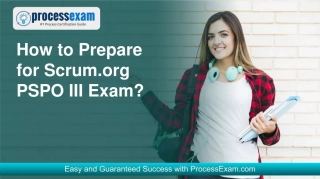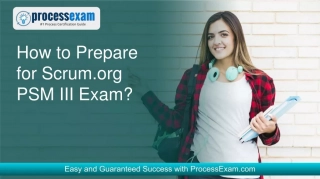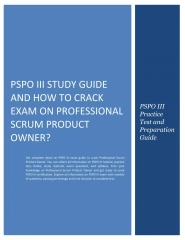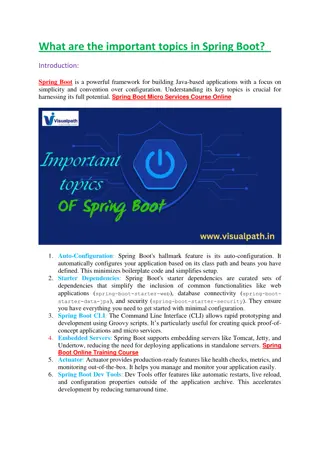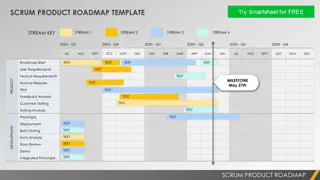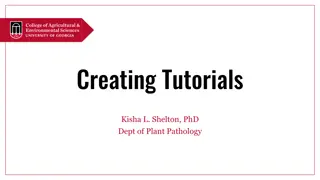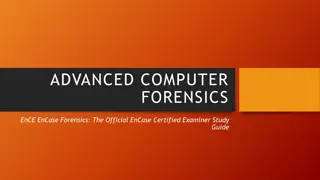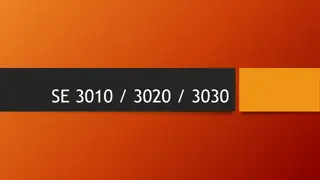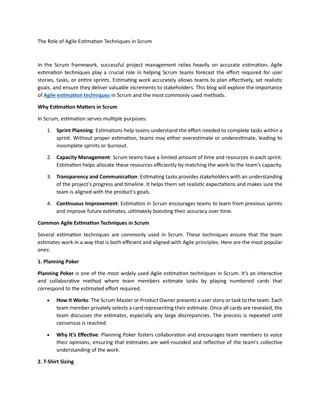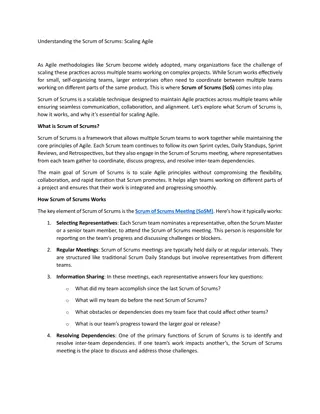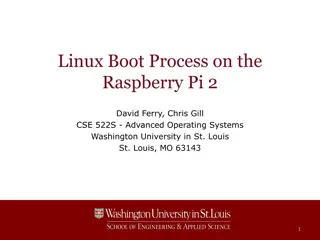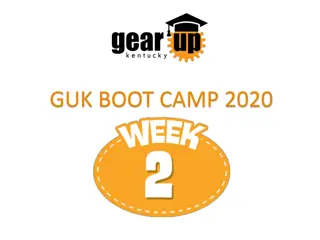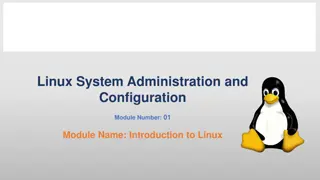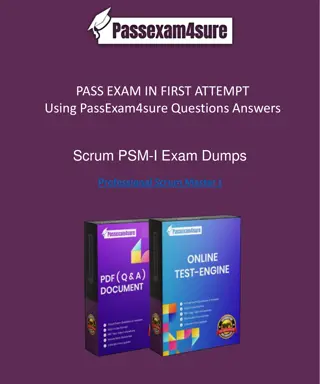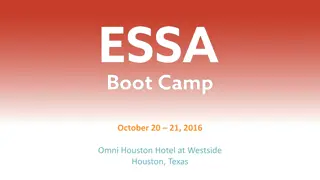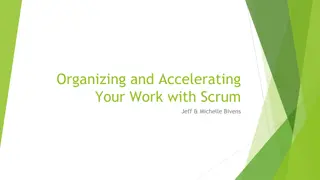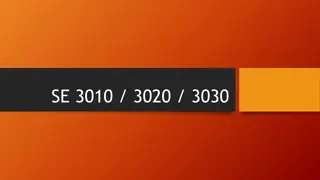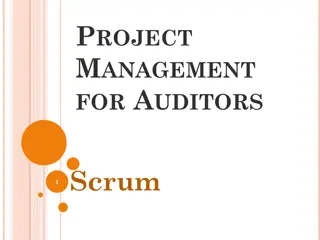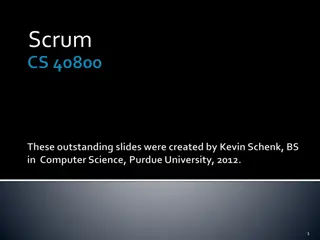Overview of Spring Boot Tutorials and Essential Scrum Practices
This content highlights various units in the Spring Boot tutorials by Javabrains and Essential Scrum practices outlined in the book "Essential Scrum" by Kenneth S. Rubin. It covers topics such as Spring Boot application development, Spring MVC, Spring Data JPA, deployment, and monitoring. The tutorial provides insights into creating Spring Boot applications, using MVC annotations, connecting to databases, and extending repository methods. On the other hand, Essential Scrum emphasizes agile processes in software development.
Download Presentation

Please find below an Image/Link to download the presentation.
The content on the website is provided AS IS for your information and personal use only. It may not be sold, licensed, or shared on other websites without obtaining consent from the author. Download presentation by click this link. If you encounter any issues during the download, it is possible that the publisher has removed the file from their server.
E N D
Presentation Transcript
CSCE 741 Software Process Lecture 04 Availability Topics Chapter 5 Availability Lecture 4 -- Spring Spring Boot assignment 1 Readings:ES Ch 4- September 13, 2017
Last Time Sprints <ES=Essential Scrum chapter 4> Abbreviations ES for Essential Scrum = Rubin, Kenneth S.. Essential Scrum: A Practical Guide to the Most Popular Agile Process (Addison- Wesley Signature Series (Cohn)) (p. 61). Pearson Education. Kindle Edition. New yyy CSCE 741 Fall 2017 2
Spring Boot Tutorials by Javabrains Google(Spring Boot Tutorial Javabrains) Spring Boot Quick Start Java Brains 1 / 34 https://javabrains.io/courses/spring_bootquickstart/ Sections 1. Unit 1 - Introducing Spring Boot 2. Unit 2 - Spring MVC: The View Tier 3. Unit 3 - Booting Spring Boot 4. Unit 4 - Spring Data JPA: The Data Tier 5. Unit 5 - Deployment and monitoring CSCE 741 Fall 2017 3
Spring Boot Tutorials Unit 1 - Introducing Spring Boot. This unit starts with an introduction to Spring Boot, why you should use it and how to get started with it. We'll create a simple Spring Boot application, add a controller and execute it to make sure it's working. Unit 2 - Spring MVC: The View Tier. This unit focuses on the view tier - with Spring MVC. Learn how to use Spring MVC annotations to map incoming REST API requests to controller methods. Learn how to access path variables and request body content to get data as well as send JSON responses from the REST API. Unit 3 - Booting Spring Boot (comments next slide) Unit 4 - Spring Data JPA: 4 Unit 5 - Deployment and monitoring CSCE 741 Fall 2017
Spring Boot Tutorials (continued) Unit 3 - Booting Spring Boot. In this unit, we'll take a slight detour and examine the various different ways in which you can create a brand new Spring Boot application. Pick your favorite one! Unit 4 - Spring Data JPA: The Data Tier. In this unit, we'll move to the data tier. We'll use the Spring Data JPA framework to connect to both an embedded Derby database as well as an external Derby database running in server mode. We'll leverage the CrudRepository to create simple CRUD operations, and also create custom find methods to extend and add new methods to the repository. Unit 5 - Deployment and monitoring CSCE 741 Fall 2017 5
Spring Boot Tutorial Unit 1 - Introducing Spring Boot 1. Introduction 2. About The Course 3. What is Spring Boot 4. Spring and some of its problems 5. What Spring Boot gives us 6. Setting Up Development Environment 7. Maven 8. Creating a Spring Boot project 9. Starting a Spring Boot application 10. Spring Boot startup steps 11. Adding a REST Controller 12. Returning Objects From Controller 13. What's Happening Here: Bill Of Materials 14. What's Happening Here: Embedded Servlet Container CSCE 741 Fall 2017 6
Unit 2 - Spring MVC: The View Tier. This unit focuses on the view tier - with Spring MVC. Learn how to use Spring MVC annotations to map incoming REST API requests to controller methods. Learn how to access path variables and request body content to get data as well as send JSON responses from the REST API. 15.How Spring MVC Works 16.The REST API we'll build 17.Creating a business service 18. Getting a single resource 19. Creating a new resource using POST 20. Implementing Update and Delete CSCE 741 Fall 2017 7
Unit 3 - Booting Spring Boot. In this unit, we'll take a slight detour and examine the various different ways in which you can create a brand new Spring Boot application. Pick your favorite one! 21. Unit Overview 22. Using Spring Initializr 23. Using Spring Boot CLI 24. Using the STS IDE 25. Using application properties CSCE 741 Fall 2017 8
Unit 4 - Spring Data JPA: The Data Tier. In this unit, we'll move to the data tier. We'll use the Spring Data JPA framework to connect to both an embedded Derby database as well as an external Derby database running in server mode. We'll leverage the CrudRepository to create simple CRUD operations, and also create custom find methods to extend and add new methods to the repository. 26.What is JPA 27. Adding Spring Data JPA 28. Creating a Spring Data JPA Repository 29. Making Crud Operations with Repository 30. Adding Course APIs 31. Adding Entity Relationship and Extending Repository CSCE 741 Fall 2017 9
Unit 5 - Deployment and monitoring 32.Packaging and running a Spring Boot app 33. Spring Boot Actuator 34. Wrap Up CSCE 741 Fall 2017 10
https://javabrains.io/courses/spring_bootquickstart/ CSCE 741 Fall 2017 11
<project xmlns="http://maven.apache.org/POM/4.0.0" xmlns:xsi="http://www.w3.org/2001/XMLSchema-instance" xsi:schemaLocation="http://maven.apache.org/POM/4.0.0 http://maven.apache.org/xsd/maven-4.0.0.xsd"> <modelVersion>4.0.0</modelVersion> <groupId>edu.sc.cse.matthews</groupId> <artifactId>course-api</artifactId> <version>0.0.1-SNAPSHOT</version> <name>Matthews Java Brains Course API</name> <parent> <groupId>org.springframework.boot</groupId> <artifactId>spring-boot-starter-parent</artifactId> <version>1.4.2.RELEASE</version> </parent> <dependencies> <dependency> <groupId>org.springframework.boot</groupId> <artifactId>spring-boot-starter-web</artifactId> </dependency> </dependencies> Pom.xml CSCE 741 Fall 2017 12
HelloController.java package edu.sc.cse.matthews.hello; import org.springframework.web.bind.annotation.RequestMapping; import org.springframework.web.bind.annotation.RestController; @RestController public class HelloController { @RequestMapping("/hello") public String sayHi(){ return("Hi"); } } CSCE 741 Fall 2017 13
http://localhost:8080/hello CSCE 741 Fall 2017 14
package edu.sc.cse.matthews.topic; Topics.java public class Topics { private String id; private String name; private String description; public Topics() { } public Topics(String id, String name, String description) { super(); this.id = id; this.name = name; this.description = description; } public String getId() { return id; } CSCE 741 Fall 2017 15
TopicsController. java package edu.sc.cse.matthews.topic; import @RestController public class TopicController { @Autowired private TopicService topicService; @RequestMapping("/topics") public List<Topics> getAllTopics(){ return topicService.getAllTopics(); } @RequestMapping("/topics/{id}") public Topics getTopic(@PathVariable String id){ return topicService.getTopic(id); } CSCE 741 Fall 2017 16
TopicsService. java @Service public class TopicService { ArrayList <> (Arrays.asList( private List<Topics> topics = new new Topics("spring", "Spring Frameowrk", "SF description"), new Topics("spring2", "Spring Frameowrk2", "SF description2"), new Topics("spring3", "Spring Frameowrk3", "SF description3"), new Topics("spring4", "Spring Framework4", "SF description4") )); public List<Topics> getAllTopics(){ return topics; } public Topics getTopic(String id){ return topics.stream().filter(t->t.getId().equals(id)).findFirst().get(); } 17 CSCE 741 Fall 2017
Spring Boot YouTube https://www.youtube.com/playlist?list=PLhd_vL3a3i7ooy1uGc_mz5C4s9Y1Pt7WZ Spring Boot - JSP YouTube https://www.youtube.com/playlist?list=PLhd_vL3a3i7om8OkPSr0flhVgSY0aS2QR Spring Boot - Bootstrap YouTube https://www.youtube.com/playlist?list=PLhd_vL3a3i7oAygrG9hVRRXADWyAwYdE1 CSCE 741 Fall 2017 18
REST Roy Fielding defined REST in his 2000 PhD dissertation "Architectural Styles and the Design of Network-based Software Architectures" at UC Irvine. Architectural properties Performance - component interactions can be the dominant factor in user-perceived performance and network efficiency[9] Scalability to support large numbers of components and interactions among components. Simplicity of a uniform Interface Modifiability of components to meet changing needs (even while the application is running) Visibility of communication between components by service agents Portability of components by moving program code with the data Reliability is the resistance to failure at the system level in the presence of failures within components, connectors, or data[9] https://en.wikipedia.org/wiki/Representational_state_transfer CSCE 741 Fall 2017 19
Architectural constraints - Six guiding constraints define a RESTful system 1. Client-server architecture 2. Statelessness 3. Cacheability 4. Layered system 5. Code on demand (optional) 6. Uniform interface https://en.wikipedia.org/wiki/Representational_state_transfer CSCE 741 Fall 2017 20
Uniform interface The uniform interface constraint is fundamental to the design of any REST service.[2] It simplifies and decouples the architecture, which enables each part to evolve independently. The four constraints for this uniform interface are: 1. Resource identification in requests 2. Resource manipulation through representations 3. Self-descriptive messages 4. Hypermedia as the engine of application state (HATEOAS) https://en.wikipedia.org/wiki/Representational_state_transfer CSCE 741 Fall 2017 21
Resource identification in requests Individual resources are identified in requests, for example using URIs in Web-based REST systems. The resources themselves are conceptually separate from the representations that are returned to the client. For example, the server may send data from its database as HTML, XML or JSON, none of which are the server's internal representation. Resource manipulation through representations When a client holds a representation of a resource, including any metadata attached, it has enough information to modify or delete the resource. https://en.wikipedia.org/wiki/Representational_state_transfer CSCE 741 Fall 2017 22
Self-descriptive messages Each message includes enough information to describe how to process the message. For example, which parser to invoke may be specified by an Internet media type (previously known as a MIME type).[2] Hypermedia as the engine of application state (HATEOAS) Having accessed an initial URI for the REST application analogous to a human Web user accessing the home page of a website a REST client should then be able to use server- provided links dynamically to discover all the available actions and resources it needs. As access proceeds, the server responds with text that includes hyperlinks to other actions that are currently available. There is no need for the client to be hard-coded with information regarding the structure or dynamics of the REST service.[12] https://en.wikipedia.org/wiki/Representational_state_transfer CSCE 741 Fall 2017 23
Spring Boot Spring Boot is the next chapter of the Spring Framework. Spring Boot won t replace the Spring Framework, because Spring Boot is the Spring Framework! Spring Boot is a new way to create Spring applications with ease. Spring Boot simplifies the way you develop, because it makes it easy to create production-ready Spring-based applications that you can just run. You will find out that, with Spring Boot, you can create standalone applications that use an embedded server, making them 100% runnable applications. Spring Boot is an opinionated technology in that it will help you follow the best practices for creating robust, extensible, and scalable Spring applications. You can find the Spring Boot project at http:// projects.spring.io/ spring-boot/ and very extensive documentation at http:// docs.spring.io/ spring-boot/ docs/ current/ reference/ htmlsingle/ . Pro Spring Boot by Gutierrez, Felipe, Ch 01 CSCE 741 Fall 2017 24
Spring Boot Home Page http:// projects.spring.io/ spring-boot/ CSCE 741 Fall 2017 25
Creating a WAR without Spring Boot CSCE 741 Fall 2017 26 Pro Spring Boot by Gutierrez, Felipe, Ch 01
Simplest Spring Web Application Groovy scripting language based on Java Avoids much of boilerplate code $ spring run app.groovy CSCE 741 Fall 2017 27 Pro Spring Boot by Gutierrez, Felipe, Ch 01
Listing 1-2. SimpleWebApp.java package com.apress.spring; import org.springframework.boot.SpringApplication; import org.springframework.boot.autoconfigure.SpringBootApplication; @SpringBootApplication public class SimpleWebApp { public static void main( String[] args){ SpringApplication.run( SimpleWebApp.class, args); } } CSCE 741 Fall 2017 28 Pro Spring Boot by Gutierrez, Felipe, Ch 01
Listing 1-3 SimpleWebController.java $ spring run *.java Typical MVC class CSCE 741 Fall 2017 29 Pro Spring Boot by Gutierrez, Felipe, Ch 01
Maven and Gradle Pom.xml $ mvn spring-boot:run Gradle $ gradle bootRun CSCE 741 Fall 2017 30 Pro Spring Boot by Gutierrez, Felipe, Ch 01
Unix tools Sts, maven, gradle, java, sudo apt-get install xxx -- Ubuntu install curl CSCE 741 Fall 2017 31
man curl curl(1) Curl Manual curl(1) NAME curl - transfer a URL SYNOPSIS curl [options] [URL...] DESCRIPTION curl is a tool to transfer data from or to a server, using one of the supported protocols (DICT, FILE, FTP, FTPS, GOPHER, HTTP, HTTPS, IMAP, IMAPS, LDAP, LDAPS, POP3, POP3S, RTMP, RTSP, SCP, SFTP, SMB, SMBS, SMTP, SMTPS, TELNET and TFTP). The command is designed to work without user interaction. CSCE 741 Fall 2017 32
X-Windows CSCE 741 Fall 2017 33 Pro Spring Boot by Gutierrez, Felipe, Ch 02
MobaXterm 129.252.130.184 CSCE 741 Fall 2017 34 Pro Spring Boot by Gutierrez, Felipe, Ch 02
Next HW Integrating Spring Boot and Schedule program CSCE 741 Fall 2017 35 Pro Spring Boot by Gutierrez, Felipe, Ch 02
CSCE 741 Fall 2017 36 Pro Spring Boot by Gutierrez, Felipe, Ch 02







